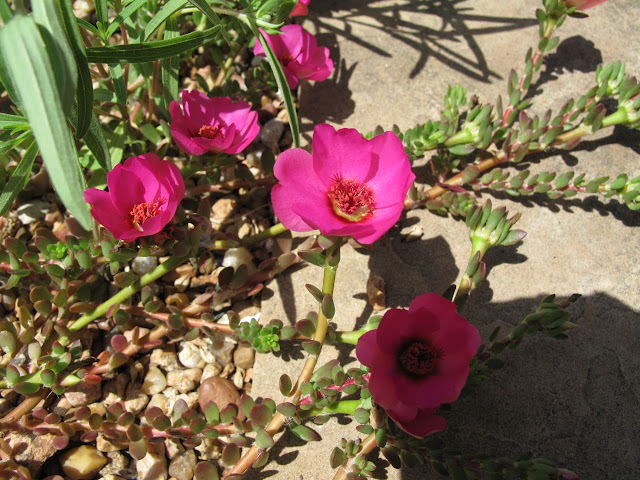 This time it was with a visit to the Denver Botanic Gardens. There were so many memorable places and vistas but I begin with one of my favorites. Is it because I am English born that this garden reminds me of so many of those wonderful English gardens?
This time it was with a visit to the Denver Botanic Gardens. There were so many memorable places and vistas but I begin with one of my favorites. Is it because I am English born that this garden reminds me of so many of those wonderful English gardens?
Our visit coincided with "Moore in the Gardens" Presenting 20 of the British sculptor Henry Moore's monumental works. Here a long shot of the same garden seen through his Oval with Points.
 We had reached this garden, the Schlessman Plaza and fragrance garden, by walking down the perennial walk. But for the fact that the walkway was paved rather than grassed I thought I was at Wisley. The long perennial walks, which originated in Europe, were designed as a rebellion against the formal gardens of the Victorian era. This was more of a mixed border with annuals mixed in among perennials but providing color and texture through all seasons.
We had reached this garden, the Schlessman Plaza and fragrance garden, by walking down the perennial walk. But for the fact that the walkway was paved rather than grassed I thought I was at Wisley. The long perennial walks, which originated in Europe, were designed as a rebellion against the formal gardens of the Victorian era. This was more of a mixed border with annuals mixed in among perennials but providing color and texture through all seasons.
Rest a while among the achillea.
 Watch the barracuda leap by the wall of water.
Watch the barracuda leap by the wall of water. Or take a minute in the shade of one of the two summer houses. Always a feature in many English gardens; a must on even a nice summer's day.
Or take a minute in the shade of one of the two summer houses. Always a feature in many English gardens; a must on even a nice summer's day. My granddad built a sunken garden in his garden. Like the walled kitchen gardens, a sunken garden would afford protection against the harsh winds, providing a microclimate. Here in Denver another garden which was to remind me of my long ago home.
My granddad built a sunken garden in his garden. Like the walled kitchen gardens, a sunken garden would afford protection against the harsh winds, providing a microclimate. Here in Denver another garden which was to remind me of my long ago home.From the English style of garden to a garden across the other side of the world; the Moongate leads into the Chinese garden. It represents the full moon and happiness.
To the Ting, which in Chinese means 'pause' inviting the visitor to stop and rest and enjoy the scenery. Not a hard thing to do on a hot day in Denver.
 The South African Garden displayed many of the plants I am familiar with. The succulents were beautifully displayed in various levels of planters.
The South African Garden displayed many of the plants I am familiar with. The succulents were beautifully displayed in various levels of planters. Stone, water and plants brought together in such a way that we would recognize this garden immediately.
Stone, water and plants brought together in such a way that we would recognize this garden immediately. Overlooking the potager, or kitchen garden with its giant headed alliums. I think I should change the name of my vegetable garden to 'potager'. It does sound so much nicer.
Overlooking the potager, or kitchen garden with its giant headed alliums. I think I should change the name of my vegetable garden to 'potager'. It does sound so much nicer. More Moore. Mother and child.
More Moore. Mother and child. Please someone tell me what these flowers are and will they grow in Texas. They were stunning en masse.
Please someone tell me what these flowers are and will they grow in Texas. They were stunning en masse. More places to sit in the shade.
More places to sit in the shade. I would love to grow this frilly cosmos too but have never had much luck with any but the native orange variety.
I would love to grow this frilly cosmos too but have never had much luck with any but the native orange variety.  And if you find the idea of a tank in your garden too 'Texas' then here's an idea with a softer look.
And if you find the idea of a tank in your garden too 'Texas' then here's an idea with a softer look. there is a little bit of everything in the gardens. Here a style that might be a little closer to home.
there is a little bit of everything in the gardens. Here a style that might be a little closer to home. A green roof, although I am not sure how this would offer much of a cooling effect.
A green roof, although I am not sure how this would offer much of a cooling effect. A recent bond, to fund parks, means that new gardens are being added all the time. I was given a peek at the new Mordecai children's garden which will open later in August. Here children were helping with the planting.
A recent bond, to fund parks, means that new gardens are being added all the time. I was given a peek at the new Mordecai children's garden which will open later in August. Here children were helping with the planting.One thing is for sure. I won't pass through Denver gain without spending a day at the gardens. Members of the Wildflower Center enter the garden without charge.

























































